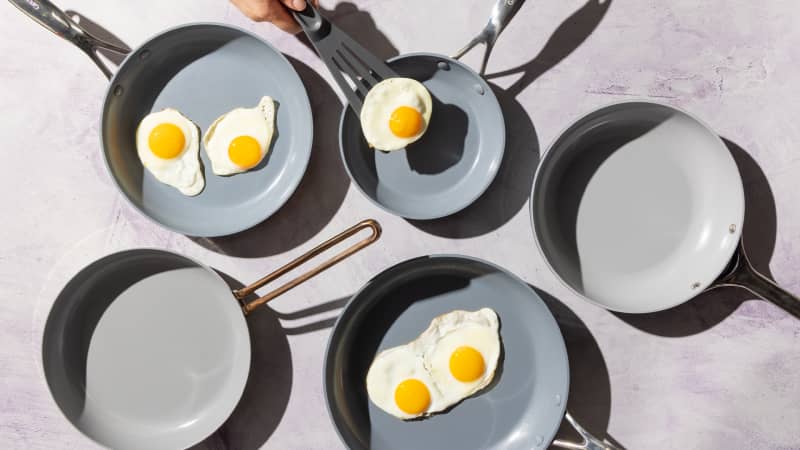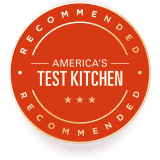Reviews you can trust.
See why.The Best Ceramic Nonstick Skillets
Ceramic skillets are supposedly a “green” alternative to traditional nonstick skillets. What are the differences? Which is better?
Published Feb. 2, 2024.

We tested two 10-inch ceramic nonstick skillets from Great Jones and Caraway. One of them fared better than the other, but neither stood up to our favorite 10-inch model, the GreenPan Valencia Pro Ceramic Nonstick 10'' Frypan.
What You Need To Know
Our favorite ceramic nonstick skillet is the GreenPan Valencia Pro Ceramic Nonstick 12'' Frypan. It’s lightweight and has a comfortable handle, making it easy to maneuver. And it’s got a broad cooking surface that is truly nonstick, unlike many of the other models we’ve tested. Our Best Buy is the Kyocera Ceramic-Coated 12" Nonstick Frypan. It has steeper sides and it felt a bit heavier in our hands, which made it a little harder to use, but its ceramic nonstick surface remained slick and durable throughout testing. Both models are induction compatible.
If you cook for two to four people, we also recommend the smaller, 10-inch versions of our top choices: the GreenPan Valencia Pro Ceramic Nonstick 10” Frypan and Kyocera Ceramic-Coated 10” Nonstick Frypan.
And if you cook for just one or two people at a time, we recommend the 8-inch versions too: the GreenPan Valencia Pro Ceramic Nonstick 8” Frypan and Kyocera Ceramic-Coated 8” Nonstick Frypan.
We also have a review of traditional nonstick skillets as well.
What You Need to Know
A good ceramic nonstick skillet can be a great alternative to a traditional nonstick skillet. Slick and easy to clean, the best ceramic nonstick skillets are ideal for cooking delicate foods such as fish and eggs. And unlike traditional nonstick skillets, ceramic nonstick skillets don’t rely on polytetrafluoroethylene (PTFE), commonly known as Teflon, to ensure that their surfaces are slippery—a plus for cooks who are concerned about the health and environmental consequences of this chemical (see below).
Historically, we’ve found that most ceramic nonstick skillets aren’t very good. Most of the models we’ve tested couldn’t release food cleanly even when they were brand new, and even the best ceramic nonstick surfaces quickly deteriorated with use. In recent years, however, we’ve found a few models that are not only consistently nonstick but also durable and easy to use—and improvements to ceramic technology are ongoing.
What Size Skillet Should You Get?
If you’re only getting one nonstick skillet, it should be a 12-inch model. It’s the most versatile size, spacious enough to cook a frittata for six people or sear four veggie burgers.
On average, the cooking surface of a 10-inch skillet is about 1 or 2 inches smaller than that of a 12-inch skillet. This size comes in handy when cooking food for two to four people.
We like an 8-inch skillet for small tasks such as frying an egg or preparing a small batch of scrambled eggs.
What’s the Difference Between Traditional Nonstick and Ceramic Nonstick?
Traditional nonstick skillets have coatings made with PTFE. Best known by the bran...
Everything We Tested

Reviews you can trust
Reviews you can trust
The mission of America’s Test Kitchen Reviews is to find the best equipment and ingredients for the home cook through rigorous, hands-on testing. We stand behind our winners so much that we even put our seal of approval on them.

Kate Shannon
Kate is a deputy editor for ATK Reviews. She's a culinary school graduate and former line cook and cheesemonger.

Valerie Sizhe Li
Valerie is an associate editor for ATK Reviews. In addition to cooking, she loves skiing, traveling, and spending time outdoors.

Miye Bromberg
Miye is a senior editor for ATK Reviews. She covers booze, blades, and gadgets of questionable value.
0 Comments